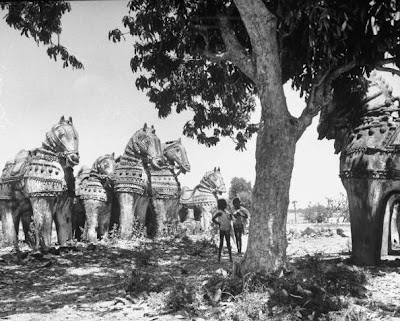Every year during Deepam five earthen-pot lighted lamps, representing the five elements, provide the flame for the single Bharani Deepam which fisherman carry to the top of the mountain for use as the source-light for the Krittikai Deepam. It is also they who are entrusted with carrying the Deepam Cauldron up to the top of the Hill prior to the day of Mahadeepam.
The Deepam cauldron is hauled up the slopes of Arunachala supported by poles inserted into the cauldron’s rings. The unique privilege for taking the flame (source-light) and cauldron up the Hill and also for the actual lighting of the Deepam Flame is always given (for long as the Hill’s recorded history) to men of the fishing caste.
The reason for the extraordinary grace shown to the fishing clan reputedly is explained by a famous legend of the time the Goddess Parvati was adopted by the king of the fishermen. A version of the story appears below.
Becoming a Fisherman
"Once, the Lord was explaining to the Goddess the secret import of the Vedas. However, the Goddess who was listening to the Lord, seemed to be beset with some anxiety and was otherwise engrossed. It was, therefore, apparent that She was listening in name only. The Lord noticed this and said that as She was not paying full attention to the important things discoursed by him she should be born in the fisherman’s community. The Goddess lamented this and the Lord assured Her that She would be born to the king of fishermen and that He (The Lord) would in due course come to wed her.
Ganapathi and Subrahmanya, the sons of the Lord were greatly perturbed by this and in their frenzy, considered the books of the Vedas to be the cause of the trouble and threw the offending books into the sea. The Lord took Nandikeswara to task for having allowed Vinayaka and Subrahmanya to go to Him without knowing His convenience and cursed him to become a shark in the sea. Any curse on Ganapathi would recoil on Him (the Lord) and hence the Lord did not impose any curse on him, however, Subrahmanya was cursed to become the dumb son of a merchant.
There was a place called Pakam on the eastern seashore of the Pandya Kingdom which was inhabited by fishermen and their king of the great fisherman clan of Paravar, was a great devotee of Lord Siva. The king had no children and one day, when he went to the sea for fishing, found a crying female child lying under a Pinnai tree (or Punnai, Calophyllam Inophyllam) on the seashore. He picked the child up with great joy and handed it to his wife saying that it was a gift of the Lord. His wife brought up the child very affectionately and adorned it with various jewels. The child grew to be a girl who constantly meditated on Lord Siva.
As ordained by the Lord, Nandikeswara became a shark and caused havoc to the fishermen’s boats sailing in the sea. The king of the fishermen took considerable pains to catch the shark – but all was in vain. The king therefore announced that he would give his daughter in marriage to any person who would catch the shark.
The Lord appeared in the guise of a young fisherman before the king of fishermen, who was struck with the personality and bearing of the young newcomer. To the king’s enquiry He replied that he was a fishermen and could net any big fish or shark. The king told him of the prize offered for netting the shark infesting the area. The newcomer went to the sea and in no time netted the shark.
The king and his men were astonished at the feat. And happily gave to the newcomer his daughter in marriage and celebrated the wedding immediately. The bride and bridegroom immediately appeared as Siva and Parvati on their Vrishabha mount and the shark also appeared as Nandikeswara.
The king of the fishermen prayed to the God extolling Him for the great kindness shown to an ordinary and illiterate man like him. The Lord told him that as he has he had been yearning to get a child for so long, he had sent Parvati as his daughter and He came himself came to wed Her. The Lord also blessed the king to have all prosperity and at the end of his life to become a denizen of Sivaloka. Then the Lord instructed Parvati about the secret import of the Vedas and She eagerly and earnestly listened to the discourse."
















